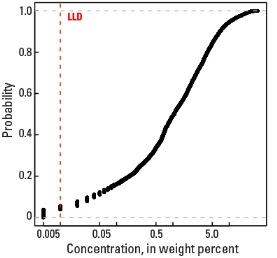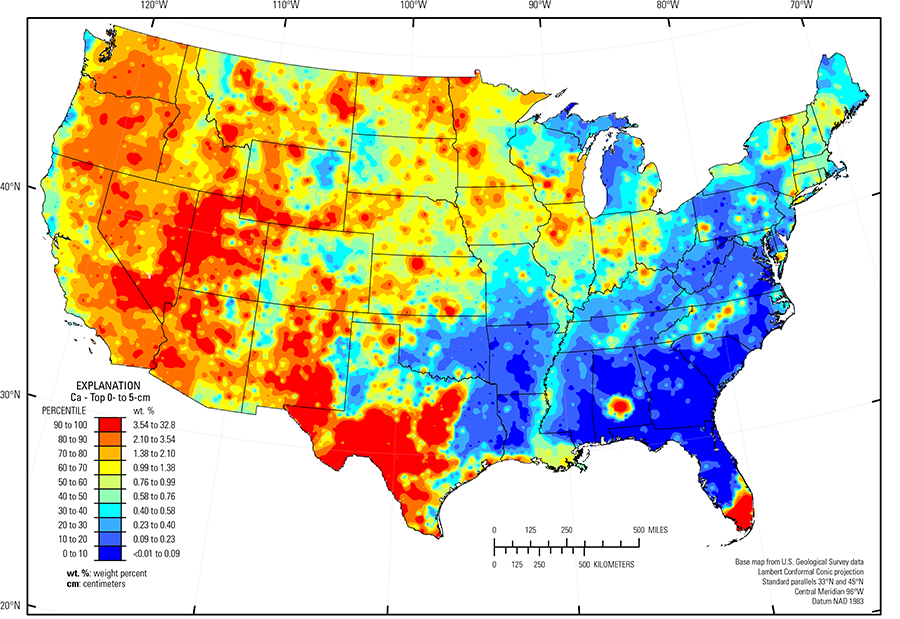
The purpose of these interpretive discussions is to provide a perspective on regional- and national-scale variations in element and mineral distributions in soils and their likely causes. The significant spatial variations shown by most elements and minerals can commonly be attributed to geologic sources in underlying parent materials, but other spatial variations seem clearly related to additional factors such as climate, the age of soils, transported source material, and anthropogenic influences. We attempt to distinguish the influence of these various factors on a regional and national scale. Numerous more local features might similarly be related to these same factors, but these features also have some probability of being an artifact of a random sampling of variable compositions, so that there is some probability of samples with similar compositions occurring in clusters of two or more adjacent sites by chance. Distinguishing such random occurrences from true variability is beyond the scope of the data from which these maps are constructed. Some caution, therefore, is advisable in interpreting the significance of these more local features unless some unique sources or processes can clearly be related to them.
Calcium (Ca) is a metallic element and the fifth most abundant element in the Earth's upper continental crust. Calcium has many uses. Metallic Ca is used in alloys. Compounds of Ca include limestone (calcium carbonate), which is used directly as a building stone and indirectly for cement, and gypsum (calcium sulfate), which is used by builders as a plaster. Calcium is essential for all living things, plant and animal. In particular, it is needed for the growth of healthy teeth and bones.
The distribution of Ca in soils is controlled by the mineralogy of underlying parent materials and the behavior and fate of Ca–bearing minerals through time in the soil environment under varying climate conditions. The average abundance of Ca in the Earth's upper continental crust is approximately 2.57 weight percent (wt. %) (Rudnick and Gao, 2003). Calcium–bearing soil parent materials can be carbonate minerals in bedrock, such as calcite (CaCO3) in limestone or dolomite (CaMg(CO3)2) in dolostone, or gypsum (CaSO4•2H2O) in evaporite deposits. Calcium also occurs in plagioclase feldspar, the most common mineral in many mafic igneous rocks, such as basalt or gabbro. Sediments derived from this diverse group of bedrock types may contain inherited Ca–bearing minerals or secondary Ca–bearing clays. Soils developed from carbonate rocks typically have higher Ca concentrations than soils developed from plagioclase–bearing mafic rocks. Calcium in carbonate rocks can make up to 30 to 50 wt. % of the bulk rock; in mafic rocks, the Ca concentration is typically less than 10 wt. %. Granites average about 0.9 wt. % Ca and sandstones about 1.3 wt. % Ca.
Calcareous soils may also contain abundant Ca in secondary calcite formed by leaching and redeposition. Calcite and other carbonate minerals in soils are readily dissolved by infiltrating rainwater or groundwater, and in temperate humid climates, the dissolved constituents may be leached from the soil profile. Many soils in arid and semiarid environments are calcareous as a lack of rainfall restricts leaching and removal of CaCO3, creating secondary, pedogenic calcite. Calcareous soils in arid and semiarid areas not directly underlain by carbonate bedrock probably result from atmospheric deposition of fine CaCO3 particles or through the influx of Ca+2 dissolved in rainfall (Machette, 1985).
In our data, the median Ca concentration is 1.05 wt. % in the soil C horizon, 0.74 wt. % in the soil A horizon, and 0.76 wt. % in the top 0- to 5-cm layer (see the summary statistics [open in new window]). The patterns for Ca in the soil A horizon and the top 0- to 5-cm layer are similar to one another, but distinct from the distribution of Ca in the soil C horizon, mainly because of carbonate leaching and formation of secondary calcite.
Much of the Ca pattern for the soil C horizon is a combination of the distribution of carbonate bedrock and plagioclase–rich mafic and intermediate igneous bedrock. For example, Ca in soils in the Texas carbonate terrane is high where limestone or other calcareous bedrock is the soil parent material. Calcium in soils of south Florida within the Everglades (USDA, 2006) developed in shallow freshwater biogenic marl forming on limestone bedrock. Carbonate bedrock also is a primary source for Ca in soils in parts of Arizona, Wyoming, and Montana, with possible contributions of Ca from secondary calcite formation. In restricted basins within the Southern Desertic Basins, Plains, and Mountains Area (USDA, 2006) and the Great Salt Lake Area (USDA, 2006), which includes the Bonneville Salt Flats, evaporation exceeds precipitation and a number of Ca–bearing minerals, such as calcite, aragonite, and gypsum, have precipitated in the surficial soil environment. Soils in the Southern High Plains (USDA, 2006) (Northern and Southern Parts) have high concentrations of Ca in the soil C horizon because of the development of pedogenic calcite. Near–surface soils (the top 0- to 5-cm layer and the soil A horizon) in these two areas are not enriched in Ca because pedogenic calcite is more prominent deeper in the soil profile. Calcium in soils in the Pacific Northwest and in parts of the Central Rocky Mountains (USDA, 2006) likely reflects inherited plagioclase feldspar in soil parent materials, which, in these areas, can include residual basalt and other mafic rocks.
The concentration of Ca in soils across the Upper Midwest reflects the distribution of glacial materials derived from sedimentary carbonate rocks. In this area, melting of glacial ice following late Wisconsinan period advances (16,000 to 12,000 years ago) left the region north of the southern glacial limit (Soller and others, 2012) mantled with a blanket of mixed, immature sediments, from which present–day soils developed. Individual ice lobes (Grimley, 2000) created distinct patterns in soil mineralogy and geochemistry because of varying provenance and ice transport paths. 'Gray' (carbonate– and shale–rich) tills in the James and Des Moines lobes (Grimley, 2000) were derived from Cretaceous sedimentary rocks (dolostone, limestone, and shale). Gray tills were transported significant distances to the south and southeast from their source and deposited in areas underlain by Precambrian bedrock. In contrast, 'red' quartz– and feldspar–rich till deposited in northeastern Minnesota, northwestern Michigan and northern Wisconsin have a Precambrian provenance with no material derived from Ca–rich carbonate bedrock. Soils in eastern Wisconsin, northern Illinois, northern Indiana, and northern Ohio developed on carbonate– and shale–bearing till sourced from sedimentary bedrock. Distinct boundaries in the soil C horizon map along the southern glacial limit (Soller and others, 2012) and between 'gray' and 'red' till clearly separate soils containing Ca from soils with low Ca concentrations. Calcium in soils in western upper New York is also derived from glacial deposits sourced from carbonate rocks.
In the soil A horizon and in the top 0- to 5-cm layer, Ca in secondary and primary carbonate minerals remains in calcareous soils in arid and semiarid regions, such as the Texas carbonate terrane and areas within the Basin and Range (Fenneman and Johnson, 1946). In more humid parts of the country, such as Minnesota, Michigan, Indiana, and Ohio, Ca is depleted where carbonate minerals have been leached out of topsoils (soil A horizon and the top 0- to 5-cm layer). In southern Florida, Ca–rich soils reflect precipitation of calcite from waters saturated with calcium carbonate, forming a biogenic marl characteristic of the Everglades (USDA, 2006). Long–term weathering of the old soil in the Piedmont (Fenneman and Johnson, 1946) has converted most carbonate and feldspar minerals to clays with Ca leached out of the soil profile.
Soils in the Gulf and Atlantic Coastal Plain (Fenneman and Johnson, 1946) developed on quartz–rich sedimentary rocks and unconsolidated sediments that never contained much original Ca. Across much of the east-central part of the country, soils developed on cyclic beds of sandstone, shale, and coal measures and have relatively low Ca concentrations. This can be seen in the Western and Central Allegheny Plateau (USDA, 2006), Cumberland Plateau (Fenneman and Johnson, 1946), and Southern Appalachian Ridges and Valleys (USDA, 2006).
Statistics - 0 TO 5 CM
| Number of samples | 4,841 |
| LLD | 0.01 wt. % |
| Number below LLD | 57 |
| Minimum | <0.01 wt. % |
| 5 percentile | 0.04 wt. % |
| 25 percentile | 0.31 wt. % |
| 50 percentile | 0.76 wt. % |
| 75 percentile | 1.71 wt. % |
| 95 percentile | 6.04 wt. % |
| Maximum | 32.8 wt. % |
| MAD | 0.815 wt. % |
| Robust CV | 107% |
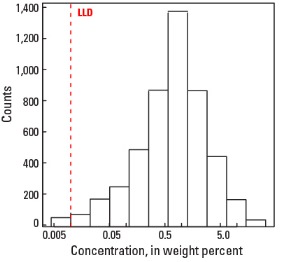
Histogram
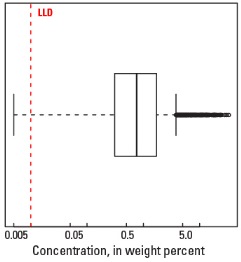
Boxplot
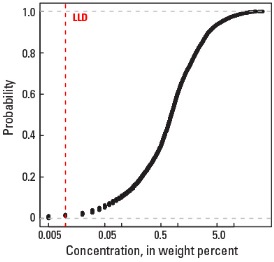
Empirical cumulative distribution function
Statistics - A Horizon
| Number of samples | 4,813 |
| LLD | 0.01 wt. % |
| Number below LLD | 57 |
| Minimum | <0.01 wt. % |
| 5 percentile | 0.04 wt. % |
| 25 percentile | 0.31 wt. % |
| 50 percentile | 0.74 wt. % |
| 75 percentile | 1.68 wt. % |
| 95 percentile | 6.13 wt. % |
| Maximum | 29.7 wt. % |
| MAD | 0.815 wt. % |
| Robust CV | 110 % |

Histogram
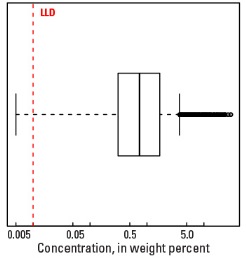
Boxplot

Empirical cumulative distribution function
Statistics - C Horizon
| Number of samples | 4,780 |
| LLD | 0.01 wt. % |
| Number below LLD | 183 |
| Minimum | <0.01 wt. % |
| 5 percentile | 0.01 wt. % |
| 25 percentile | 0.27 wt. % |
| 50 percentile | 1.05 wt. % |
| 75 percentile | 3.36 wt. % |
| 95 percentile | 10.5 wt. % |
| Maximum | 32.3 wt. % |
| MAD | 1.51 wt. % |
| Robust CV | 144 % |
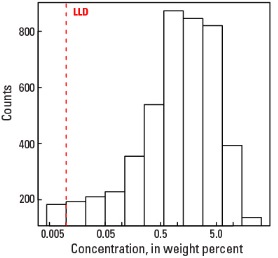
Histogram
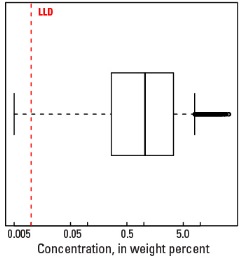
Boxplot
